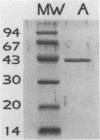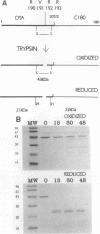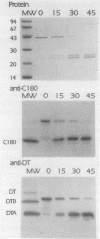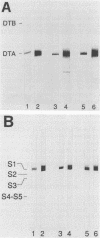Abstract
A genetically engineered gene fusion was constructed which encoded a nontoxic derivative of the A fragment of diphtheria toxin joined to the C180 peptide of the S1 subunit of pertussis toxin. The product of this gene fusion, termed the DTA-C180 protein, was purified from the periplasm of Escherichia coli to approximately 80% purity. The DTA-C180 protein possessed an apparent molecular weight of 43,000 by reduced sodium dodecyl sulfate-polyacrylamide gel electrophoresis. The DTA-C180 protein was cleaved into two tryptic peptides, which migrated with apparent molecular weights of approximately 22,000. One tryptic peptide reacted with diphtheria antitoxin, while the other tryptic peptide reacted with anti-C180 peptide immunoglobulin G. The DTA-C180 protein did not inhibit protein synthesis or stimulate clustering morphology in Chinese hamster ovary cells. The DTA-C180 protein elicited an immune response, in guinea pigs, against both the DTA and C180 peptide components of the fusion protein, with alum being a more efficient adjuvant than Freund's adjuvant for eliciting neutralization titers. Neutralization titers elicited by DTA-C180 protein were weaker than those elicited by diphtheria toxoid and pertussis toxin 9K/129G, a genetically engineered double mutant of pertussis toxin. Three doses of DTA-C180 protein yielded a neutralization titer of 1/750 against pertussis toxin in Chinese hamster ovary cells and a neutralization titer of 1/50 against diphtheria toxin in Vero cells. This is the first report of a protein derived from a recombinant S1 subunit that elicits a neutralizing titer against pertussis toxin.
Full text
PDF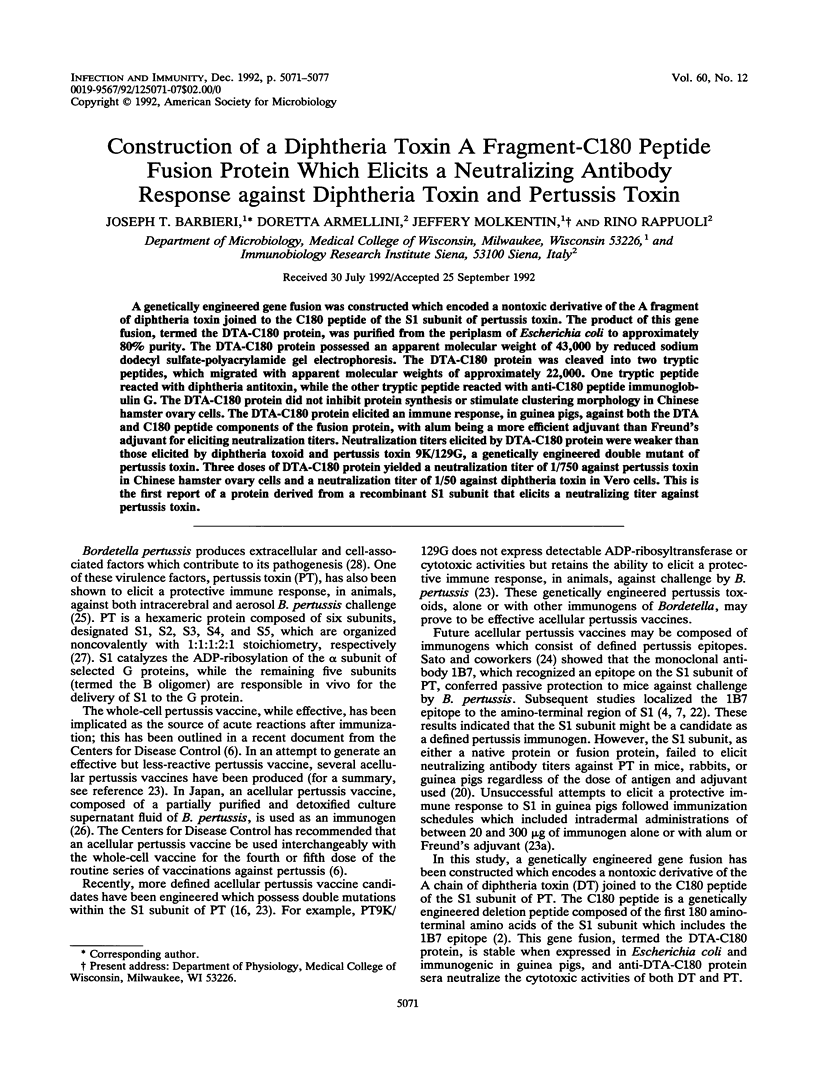
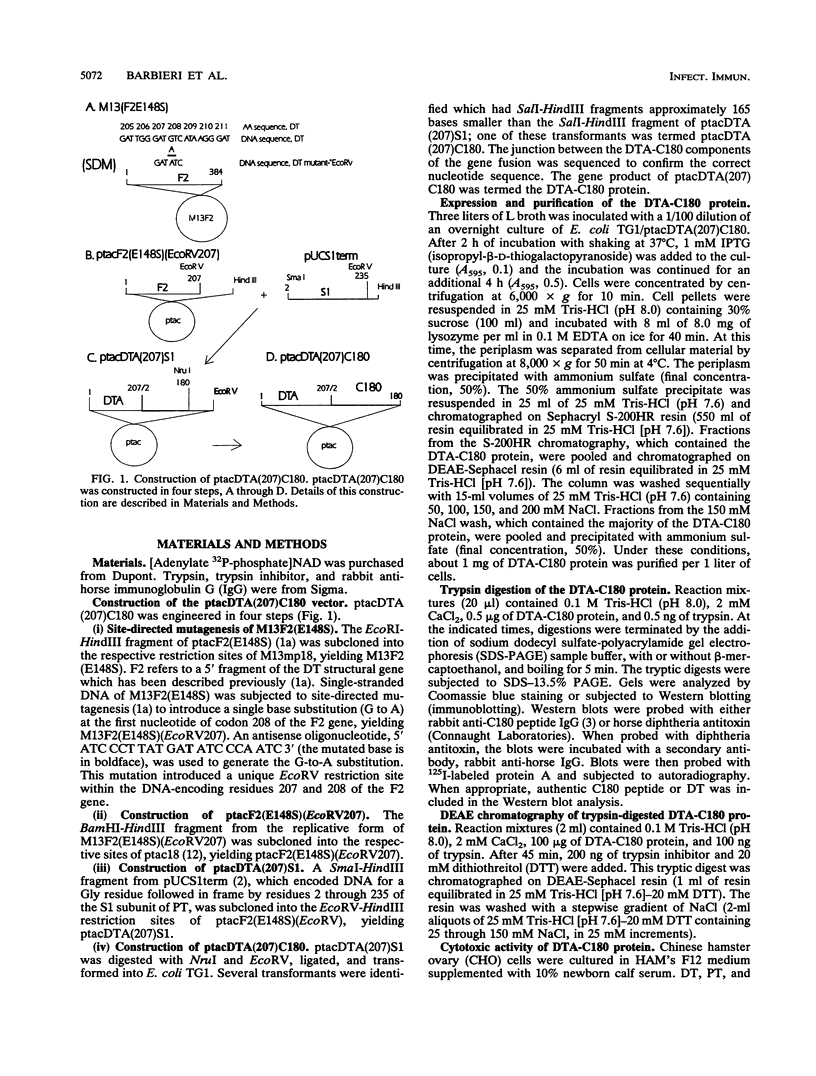
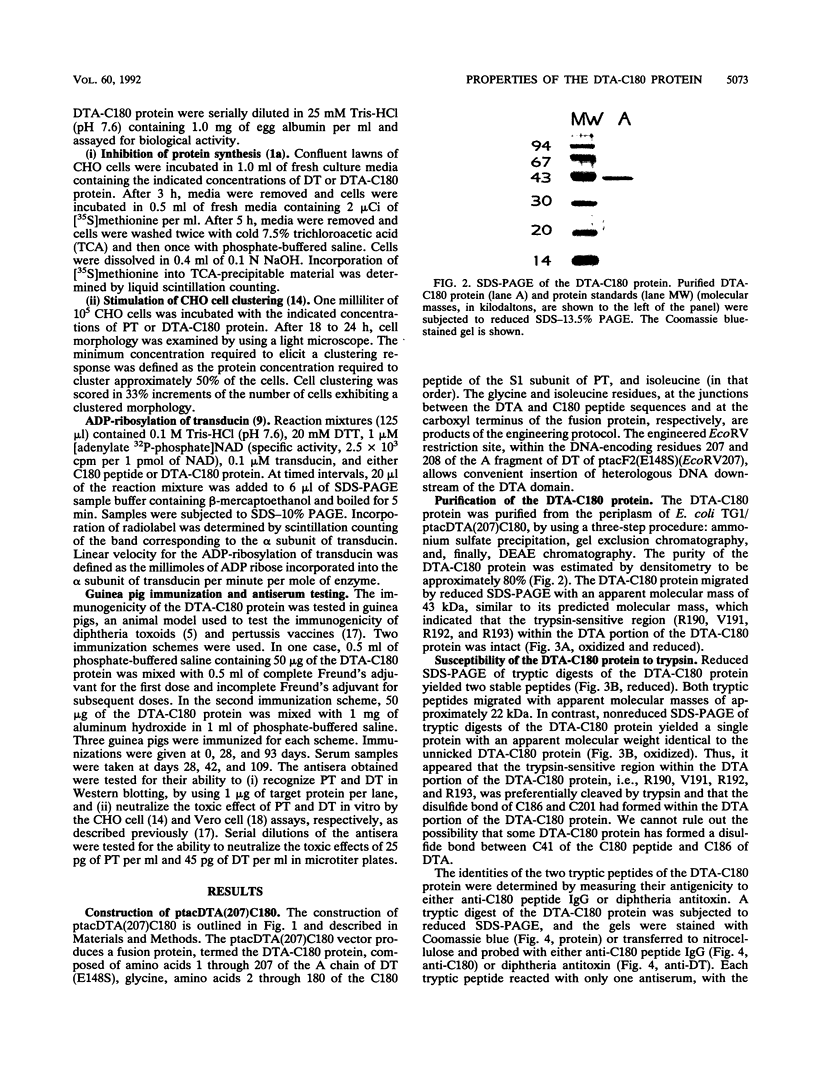
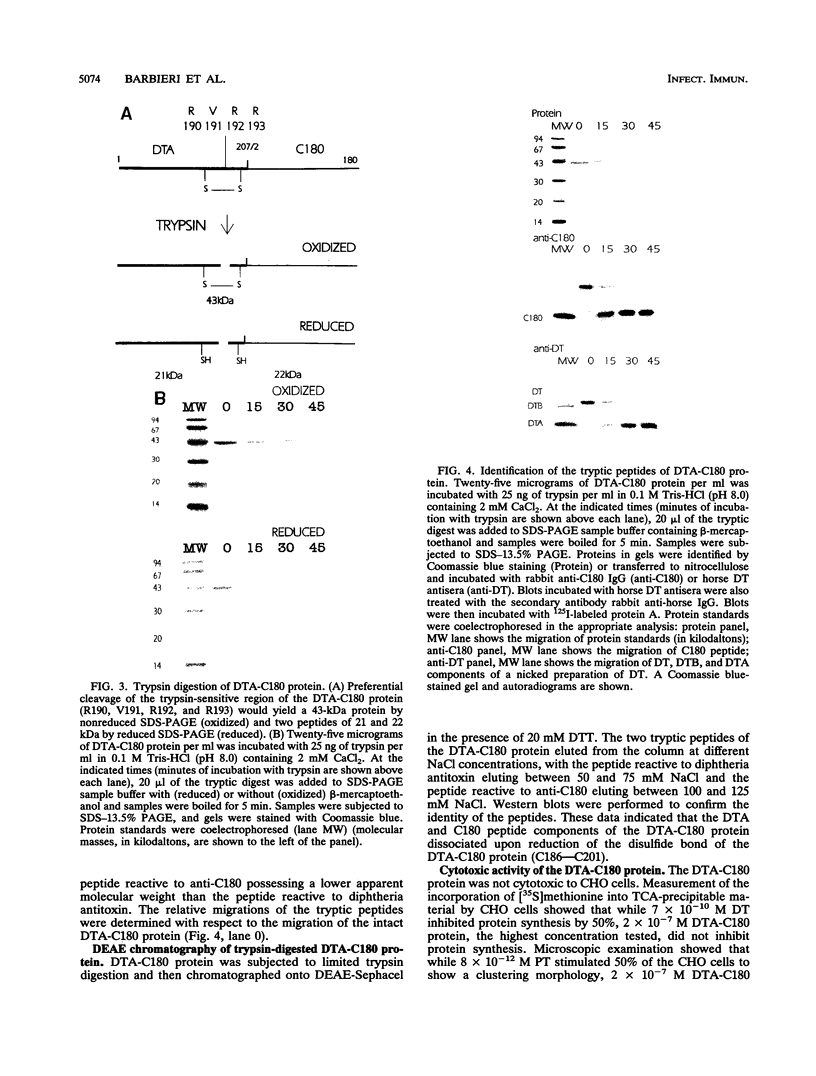
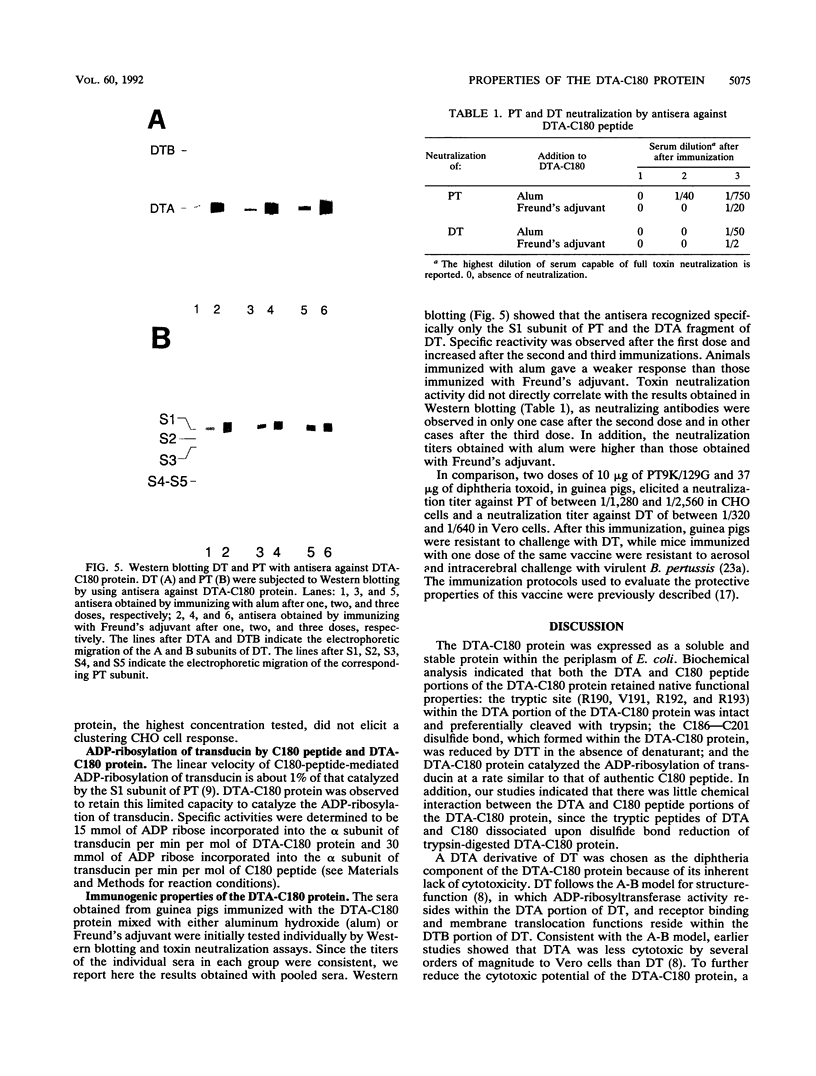
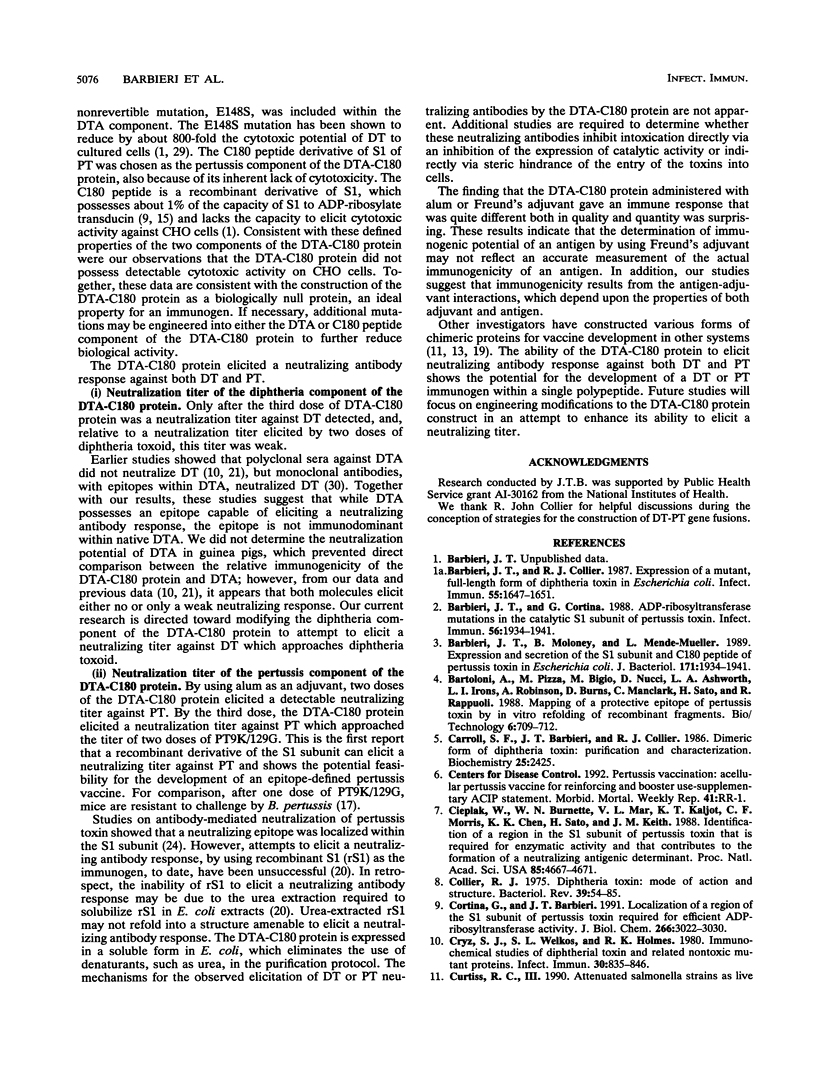
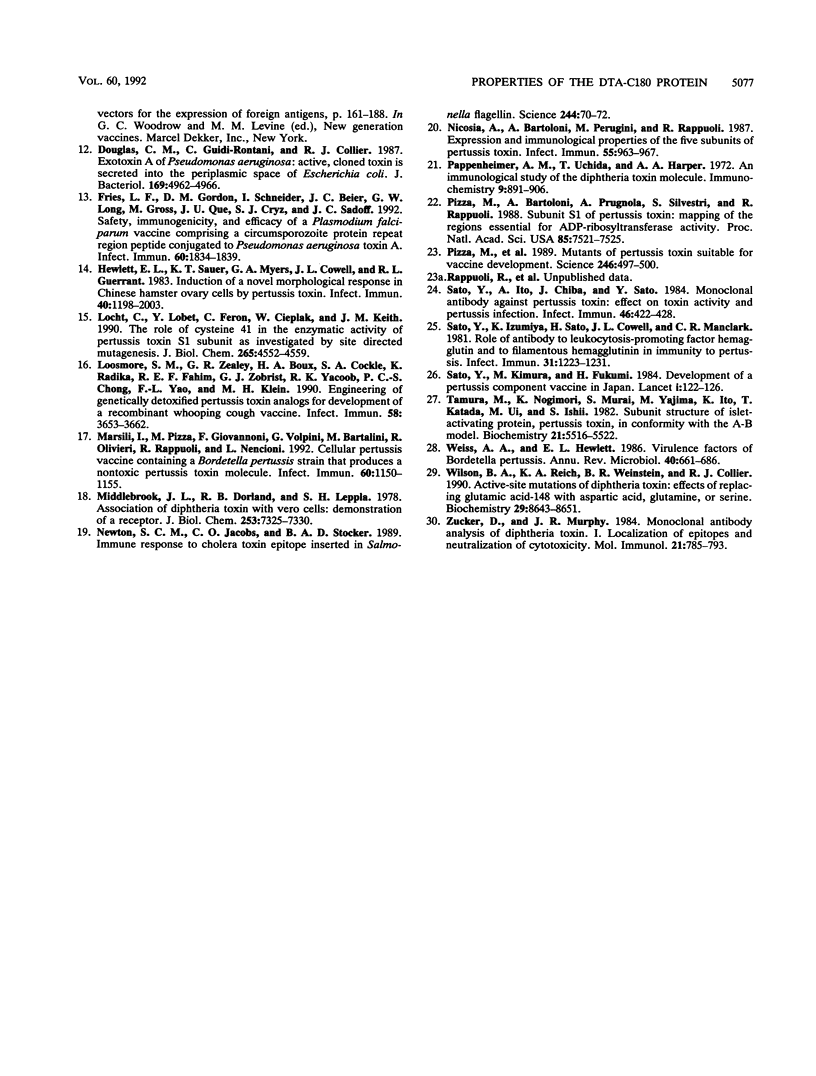
Images in this article
Selected References
These references are in PubMed. This may not be the complete list of references from this article.
- Barbieri J. T., Collier R. J. Expression of a mutant, full-length form of diphtheria toxin in Escherichia coli. Infect Immun. 1987 Jul;55(7):1647–1651. doi: 10.1128/iai.55.7.1647-1651.1987. [DOI] [PMC free article] [PubMed] [Google Scholar]
- Barbieri J. T., Cortina G. ADP-ribosyltransferase mutations in the catalytic S-1 subunit of pertussis toxin. Infect Immun. 1988 Aug;56(8):1934–1941. doi: 10.1128/iai.56.8.1934-1941.1988. [DOI] [PMC free article] [PubMed] [Google Scholar]
- Carroll S. F., Barbieri J. T., Collier R. J. Dimeric form of diphtheria toxin: purification and characterization. Biochemistry. 1986 May 6;25(9):2425–2430. doi: 10.1021/bi00357a019. [DOI] [PubMed] [Google Scholar]
- Cieplak W., Burnette W. N., Mar V. L., Kaljot K. T., Morris C. F., Chen K. K., Sato H., Keith J. M. Identification of a region in the S1 subunit of pertussis toxin that is required for enzymatic activity and that contributes to the formation of a neutralizing antigenic determinant. Proc Natl Acad Sci U S A. 1988 Jul;85(13):4667–4671. doi: 10.1073/pnas.85.13.4667. [DOI] [PMC free article] [PubMed] [Google Scholar]
- Collier R. J. Diphtheria toxin: mode of action and structure. Bacteriol Rev. 1975 Mar;39(1):54–85. doi: 10.1128/br.39.1.54-85.1975. [DOI] [PMC free article] [PubMed] [Google Scholar]
- Cortina G., Barbieri J. T. Localization of a region of the S1 subunit of pertussis toxin required for efficient ADP-ribosyltransferase activity. J Biol Chem. 1991 Feb 15;266(5):3022–3030. [PubMed] [Google Scholar]
- Cryz S. J., Welkos S. L., Holmes R. K. Immunochemical studies of diphtherial toxin and related nontoxic mutant proteins. Infect Immun. 1980 Dec;30(3):835–846. doi: 10.1128/iai.30.3.835-846.1980. [DOI] [PMC free article] [PubMed] [Google Scholar]
- Douglas C. M., Guidi-Rontani C., Collier R. J. Exotoxin A of Pseudomonas aeruginosa: active, cloned toxin is secreted into the periplasmic space of Escherichia coli. J Bacteriol. 1987 Nov;169(11):4962–4966. doi: 10.1128/jb.169.11.4962-4966.1987. [DOI] [PMC free article] [PubMed] [Google Scholar]
- Fries L. F., Gordon D. M., Schneider I., Beier J. C., Long G. W., Gross M., Que J. U., Cryz S. J., Sadoff J. C. Safety, immunogenicity, and efficacy of a Plasmodium falciparum vaccine comprising a circumsporozoite protein repeat region peptide conjugated to Pseudomonas aeruginosa toxin A. Infect Immun. 1992 May;60(5):1834–1839. doi: 10.1128/iai.60.5.1834-1839.1992. [DOI] [PMC free article] [PubMed] [Google Scholar]
- Hewlett E. L., Sauer K. T., Myers G. A., Cowell J. L., Guerrant R. L. Induction of a novel morphological response in Chinese hamster ovary cells by pertussis toxin. Infect Immun. 1983 Jun;40(3):1198–1203. doi: 10.1128/iai.40.3.1198-1203.1983. [DOI] [PMC free article] [PubMed] [Google Scholar]
- Locht C., Lobet Y., Feron C., Cieplak W., Keith J. M. The role of cysteine 41 in the enzymatic activities of the pertussis toxin S1 subunit as investigated by site-directed mutagenesis. J Biol Chem. 1990 Mar 15;265(8):4552–4559. [PubMed] [Google Scholar]
- Loosmore S. M., Zealey G. R., Boux H. A., Cockle S. A., Radika K., Fahim R. E., Zobrist G. J., Yacoob R. K., Chong P. C., Yao F. L. Engineering of genetically detoxified pertussis toxin analogs for development of a recombinant whooping cough vaccine. Infect Immun. 1990 Nov;58(11):3653–3662. doi: 10.1128/iai.58.11.3653-3662.1990. [DOI] [PMC free article] [PubMed] [Google Scholar]
- Marsili I., Pizza M., Giovannoni F., Volpini G., Bartalini M., Olivieri R., Rappuoli R., Nencioni L. Cellular pertussis vaccine containing a Bordetella pertussis strain that produces a nontoxic pertussis toxin molecule. Infect Immun. 1992 Mar;60(3):1150–1155. doi: 10.1128/iai.60.3.1150-1155.1992. [DOI] [PMC free article] [PubMed] [Google Scholar]
- Middlebrook J. L., Dorland R. B., Leppla S. H. Association of diphtheria toxin with Vero cells. Demonstration of a receptor. J Biol Chem. 1978 Oct 25;253(20):7325–7330. [PubMed] [Google Scholar]
- Newton S. M., Jacob C. O., Stocker B. A. Immune response to cholera toxin epitope inserted in Salmonella flagellin. Science. 1989 Apr 7;244(4900):70–72. doi: 10.1126/science.2468182. [DOI] [PubMed] [Google Scholar]
- Nicosia A., Bartoloni A., Perugini M., Rappuoli R. Expression and immunological properties of the five subunits of pertussis toxin. Infect Immun. 1987 Apr;55(4):963–967. doi: 10.1128/iai.55.4.963-967.1987. [DOI] [PMC free article] [PubMed] [Google Scholar]
- Pappenheimer A. M., Jr, Uchida T., Harper A. A. An immunological study of the diphtheria toxin molecule. Immunochemistry. 1972 Sep;9(9):891–906. doi: 10.1016/0019-2791(72)90163-2. [DOI] [PubMed] [Google Scholar]
- Pizza M., Bartoloni A., Prugnola A., Silvestri S., Rappuoli R. Subunit S1 of pertussis toxin: mapping of the regions essential for ADP-ribosyltransferase activity. Proc Natl Acad Sci U S A. 1988 Oct;85(20):7521–7525. doi: 10.1073/pnas.85.20.7521. [DOI] [PMC free article] [PubMed] [Google Scholar]
- Pizza M., Covacci A., Bartoloni A., Perugini M., Nencioni L., De Magistris M. T., Villa L., Nucci D., Manetti R., Bugnoli M. Mutants of pertussis toxin suitable for vaccine development. Science. 1989 Oct 27;246(4929):497–500. doi: 10.1126/science.2683073. [DOI] [PubMed] [Google Scholar]
- Sato H., Ito A., Chiba J., Sato Y. Monoclonal antibody against pertussis toxin: effect on toxin activity and pertussis infections. Infect Immun. 1984 Nov;46(2):422–428. doi: 10.1128/iai.46.2.422-428.1984. [DOI] [PMC free article] [PubMed] [Google Scholar]
- Sato Y., Izumiya K., Sato H., Cowell J. L., Manclark C. R. Role of antibody to leukocytosis-promoting factor hemagglutinin and to filamentous hemagglutinin in immunity to pertussis. Infect Immun. 1981 Mar;31(3):1223–1231. doi: 10.1128/iai.31.3.1223-1231.1981. [DOI] [PMC free article] [PubMed] [Google Scholar]
- Sato Y., Kimura M., Fukumi H. Development of a pertussis component vaccine in Japan. Lancet. 1984 Jan 21;1(8369):122–126. doi: 10.1016/s0140-6736(84)90061-8. [DOI] [PubMed] [Google Scholar]
- Tamura M., Nogimori K., Murai S., Yajima M., Ito K., Katada T., Ui M., Ishii S. Subunit structure of islet-activating protein, pertussis toxin, in conformity with the A-B model. Biochemistry. 1982 Oct 26;21(22):5516–5522. doi: 10.1021/bi00265a021. [DOI] [PubMed] [Google Scholar]
- Weiss A. A., Hewlett E. L. Virulence factors of Bordetella pertussis. Annu Rev Microbiol. 1986;40:661–686. doi: 10.1146/annurev.mi.40.100186.003305. [DOI] [PubMed] [Google Scholar]
- Wilson B. A., Reich K. A., Weinstein B. R., Collier R. J. Active-site mutations of diphtheria toxin: effects of replacing glutamic acid-148 with aspartic acid, glutamine, or serine. Biochemistry. 1990 Sep 18;29(37):8643–8651. doi: 10.1021/bi00489a021. [DOI] [PubMed] [Google Scholar]
- Zucker D. R., Murphy J. R. Monoclonal antibody analysis of diphtheria toxin--I. Localization of epitopes and neutralization of cytotoxicity. Mol Immunol. 1984 Sep;21(9):785–793. doi: 10.1016/0161-5890(84)90165-2. [DOI] [PubMed] [Google Scholar]



